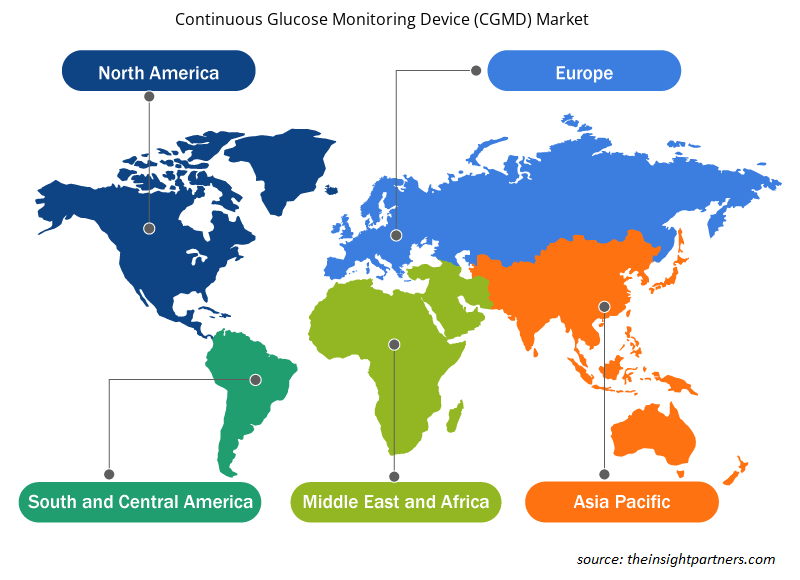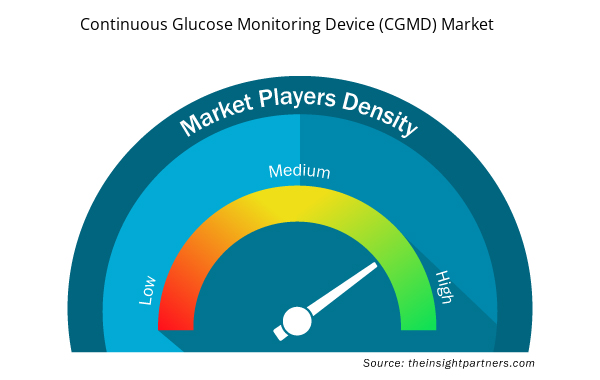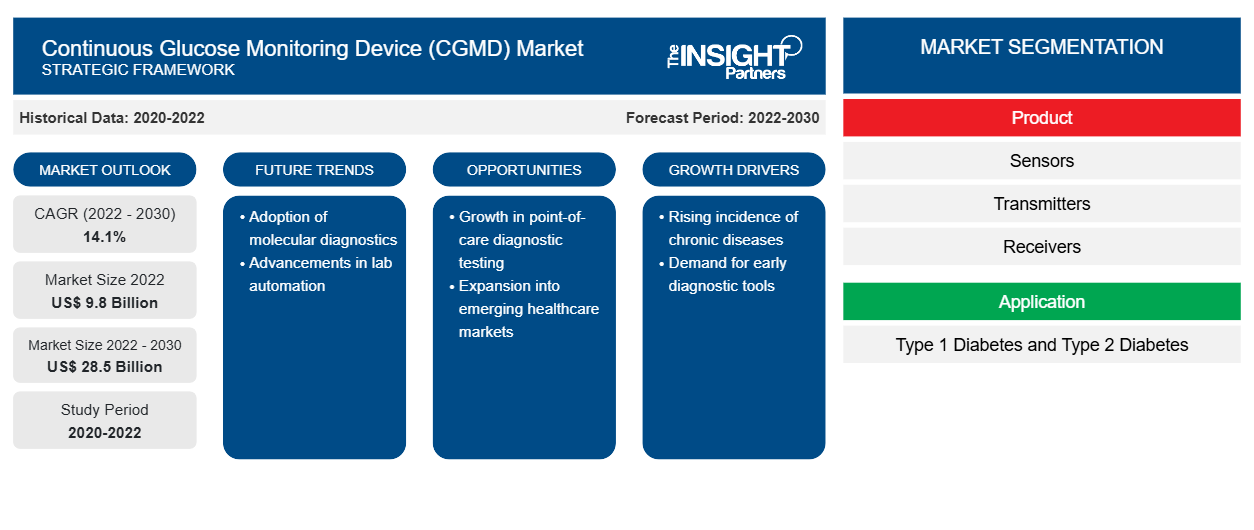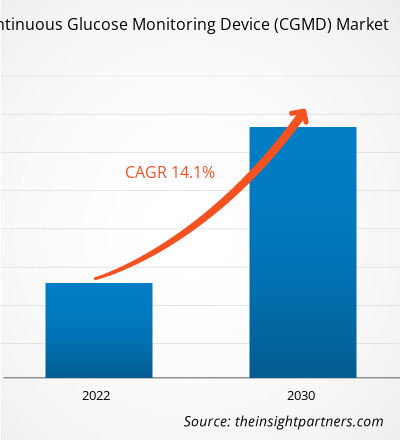[調査レポート] 持続血糖モニタリング装置市場は、2022年の98億米ドルから2030年には285億米ドルに成長すると予測されており、2022年から2030年にかけて市場は14.1%のCAGRを記録すると予測されています。
市場洞察とアナリストの見解:
持続血糖モニタリング装置市場の予測は、この市場の関係者が成長戦略を計画するのに役立ちます。糖尿病患者の間では自己血糖測定装置よりも持続血糖測定装置が好まれる傾向が高まっており、これが市場の成長を牽引しています。しかし、製品リコールが持続血糖測定装置市場の成長を妨げています。
成長の原動力:
糖尿病管理における継続的なモニタリングの重要性が高まり、持続血糖モニタリング装置の市場規模が拡大
現在、糖尿病の管理は非常に複雑です。糖尿病は、人々が新しい生活習慣や投薬などを生み出す結果となるからです。さらに、糖尿病に苦しむ人々は、血糖値を注意深く監視する必要があります。糖尿病患者の間では、維持するのが難しい高血糖値のため、持続血糖モニタリングデバイスの需要が高くなっています。これらのデバイスは、センサー、トランスミッター、モニターなどのコンポーネントを使用して、手動の糖尿病管理を一新した最先端のテクノロジーデバイスです。持続血糖モニタリングデバイスのスマート機能により、糖尿病患者に血糖値に関するリアルタイムの更新が提供され、医療医師の指示に従って食事パターンやインスリン投与量を変更するのに役立ちます。このようなリアルタイムの更新により、糖尿病患者の低血糖や高血糖のリスクが軽減されます。さらに、近年、主にCOVID-19パンデミック中に医療機器業界が大幅に拡大したことで、持続血糖モニタリングデバイスの市場規模にプラスの影響を与えています。持続血糖モニタリングデバイステクノロジーの進歩により、糖尿病患者の生活は楽になりました。たとえば、インスリン投与や血糖値のモニタリングは、毎日何度も指を刺す作業から、携帯電話を数回スワイプする作業へと変化しました。
要件に合わせてレポートをカスタマイズする
このレポートの一部、国レベルの分析、Excelデータパックなど、あらゆるレポートを無料でカスタマイズできます。また、スタートアップや大学向けのお得なオファーや割引もご利用いただけます。
- このレポートの主要な市場動向を入手してください。この無料サンプルには、市場動向から見積もりや予測に至るまでのデータ分析が含まれます。
レポートのセグメンテーションと範囲:
「持続血糖モニタリング装置市場分析」は、製品、アプリケーション、テストサイト、エンドユーザーというセグメントを考慮して実施されました。
セグメント分析:
製品別に見ると、市場はセンサー、トランスミッター、レシーバーに分かれています。センサーセグメントは、2022年に最大の持続血糖モニタリングデバイスの市場シェアを占めました。同じセグメントは、予測期間中に14.6%という最高のCAGRを記録すると予想されています。 2024年1月、Dexcomは「Steloグルコースセンサー」という新しいグルコースセンサーの承認を食品医薬品局(FDA)に提出すると発表しました。この新しいセンサーは、特に2型糖尿病患者向けに設計されたデバイスに適応しており、食事、運動、睡眠、ストレスの維持を通じて健康状態を監視できます。「低中所得国における自己モニタリングデバイス」レポートによると、主要な持続血糖モニタリングデバイスサプライヤー(Abbott、Dexcom、Medtronic)の収益は、主にセンサーによって推進されています。また、患者はセンサーを頻繁に(平均10〜14日ごとに)使用することを好みます。したがって、センサーは持続血糖モニタリングデバイス市場の総売上収益の60〜90%を占めています。
テクノロジートレンド
糖尿病治療では、さまざまなデバイスやツールが最新のテクノロジーで実現されているため、テクノロジーが重要な役割を果たしています。持続血糖モニタリングデバイスのメーカーは、高所得市場ではなく低・中所得(LMIC)市場をターゲットにしています。これらの国の糖尿病患者は、特にこれらのデバイスの払い戻しが適切であれば、持続血糖モニタリングデバイス製品に切り替えると予想しているためです。さらに、反復的な自己モニタリングの代わりに継続的なモニタリングを行うことで、さらなる安心感が得られます。自動治療提供システム(インスリンポンプなど)と統合された持続血糖モニタリングデバイスは、持続血糖モニタリングデバイスの測定値に基づいてインスリン投与量を手動で調整する必要がないため、個人にメリットを提供できます。したがって、持続血糖モニタリングデバイスの進歩により、今後数年間で新たな持続血糖モニタリングデバイス市場のトレンドがもたらされる可能性があります。
地域分析:
持続血糖モニタリング装置市場レポートの地理的範囲には、北米、ヨーロッパ、アジア太平洋、中南米、中東およびアフリカが含まれます。2022年には、北米が最大の持続血糖モニタリング装置市場シェアを占めました。この地域の市場成長は、この地域の主要市場プレーヤーの存在に加えて、トップ企業による製品発売数の増加によって推進されています。米国は北米市場への最大の貢献者です。糖尿病の有病率の上昇は、米国での持続血糖モニタリング装置の需要を加速させる重要な要因です。また、最新のテクノロジーを利用した製品へのアクセスは、この国の持続血糖モニタリング装置市場の成長に有利に働いています。2021年に米国糖尿病協会の報告書で発表された統計によると、全人口の3,840万人(11.6%)のアメリカ人が糖尿病を患っており、そのうち2,970万人が診断済み、870万人が未診断でした。アボット社の「FreeStyle Libre 2」は、先進技術をベースとした持続血糖モニタリング デバイス製品の一例であり、市場で最も長持ちする統合持続血糖モニタリング (iCGM) システムです。患者に 1 分ごとに血糖値を提供します。また、FreeStyle Libre 2 は、成人と 4 歳以上の子供の 2 つの年齢層の患者に使用できる、米国で唯一の統合 iCGM システムです。
持続血糖モニタリング装置 (CGMD)
持続血糖測定装置(CGMD)市場の地域別分析
予測期間を通じて持続血糖モニタリング装置 (CGMD) 市場に影響を与える地域的な傾向と要因は、Insight Partners のアナリストによって徹底的に説明されています。このセクションでは、北米、ヨーロッパ、アジア太平洋、中東およびアフリカ、南米および中米にわたる持続血糖モニタリング装置 (CGMD) 市場のセグメントと地域についても説明します。

- 持続血糖測定装置(CGMD)市場の地域別データを入手
持続血糖測定装置(CGMD)市場レポートの範囲
| レポート属性 | 詳細 |
|---|---|
| 2022年の市場規模 | 98億米ドル |
| 2030年までの市場規模 | 285億米ドル |
| 世界のCAGR(2022年 - 2030年) | 14.1% |
| 履歴データ | 2020-2022 |
| 予測期間 | 2022-2030 |
| 対象セグメント | 製品別
|
| 対象地域と国 | 北米
|
| 市場リーダーと主要企業プロフィール |
|
持続血糖モニタリング装置(CGMD)市場のプレーヤー密度:ビジネスダイナミクスへの影響を理解する
持続血糖モニタリング装置 (CGMD) 市場は、消費者の嗜好の変化、技術の進歩、製品の利点に対する認識の高まりなどの要因により、エンドユーザーの需要が高まり、急速に成長しています。需要が高まるにつれて、企業は提供を拡大し、消費者のニーズを満たすために革新し、新たなトレンドを活用し、市場の成長をさらに促進しています。
市場プレーヤー密度とは、特定の市場または業界内で活動している企業または会社の分布を指します。これは、特定の市場スペースに、その規模または総市場価値と比較して、どれだけの競合相手 (市場プレーヤー) が存在するかを示します。
持続血糖モニタリング装置(CGMD)市場で事業を展開している主要企業は次のとおりです。
- B.ブラウンSE
- F.ホフマン・ラ・ロシュ株式会社
- ライフスキャン株式会社
- メドトロニック
- アボットラボラトリーズ
免責事項:上記の企業は、特定の順序でランク付けされていません。

- 持続血糖モニタリング装置(CGMD)市場のトップキープレーヤーの概要を入手
業界の発展と将来の機会:
プレスリリースによると、持続血糖モニタリングデバイス市場で活動している主要企業による戦略的開発のいくつかを以下に示します。
- 2023年10月、フィリップス・メディサイズは、独自の非侵襲性ウェアラブルデバイスを商品化するためにグルコモディックと提携すると発表しました。この提携は、血糖値をより適切に監視する方法を求めている糖尿病患者のために、針を使わず、正確で、より手頃な価格のソリューションを生み出すことを目的としています。
- 2024 年 1 月、メドトロニックは、指を刺したりテープを貼りすぎたりする必要のない使い捨てのオールインワン持続血糖測定装置、Simplera Sync を搭載した「MiniMed 780G システム」の CE マーク承認を発表しました。この新製品はヨーロッパで販売される予定で、メドトロニックは 2024 年春にヨーロッパで段階的に販売を開始しました。
- 2023年12月、Dexcomは持続血糖測定装置の新製品「Dexcom G7」の発売を発表しました。新製品の発売は、t: slim X2インスリンポンプに接続する最小かつ最も正確な持続血糖測定装置です。この製品は、t: slim X2ポンプに接続し、30分間のセンサーウォームアップ*を行う最速の持続血糖測定装置であり、Dexcom G6と並んで、指を刺すことなくアラートを求める唯一の持続血糖測定装置システムです。
競争環境と主要企業:
B. Braun SE、F. Hoffmann-La-Roche Ltd、LifeScan Inc、Medtronic、Abbott Laboratories、Ypsomed Holding AG、Sensionics、Nipro Corp、GE Healthcare、および Terumo Corp は、持続血糖測定装置市場レポートで紹介されている著名な企業の一部です。これらの企業は、新しい技術の開発、既存製品のアップグレード、および世界中で高まる消費者の需要を満たすための地理的プレゼンスの拡大に重点を置いています。
- 過去2年間の分析、基準年、CAGRによる予測(7年間)
- PEST分析とSWOT分析
- 市場規模価値/数量 - 世界、地域、国
- 業界と競争環境
- Excel データセット



Report Coverage
Revenue forecast, Company Analysis, Industry landscape, Growth factors, and Trends

Segment Covered
This text is related
to segments covered.

Regional Scope
North America, Europe, Asia Pacific, Middle East & Africa, South & Central America

Country Scope
This text is related
to country scope.
よくある質問
Continuous glucose monitoring utilizes a device to automatically estimate blood glucose levels throughout the day and night. Monitoring continuous blood glucose levels in real-time can assist physicians in making informed decisions about the food and beverages the patient consumes, physical activity, and medications.
The CAGR value of the continuous glucose monitoring devices market during the forecasted period of 2022-2030 is 14.1%.
Key factors that are driving the growth of this market are high adoption of CGMD for diabetes management is expected to boost the market growth for the continuous glucose monitoring devices over the years.
The sensors segment held the largest share of the market in the global continuous glucose monitoring devices market and held the largest market share in 2022.
The type 2 diabetes segment dominated the global continuous glucose monitoring devices market and held the largest market share in 2022.
F. Hoffmann-La-Roche Ltd and Medtronic are the top two companies that hold huge market shares in the continuous glucose monitoring devices market.
The continuous glucose monitoring devices market majorly consists of the players such B. Braun SE, F. Hoffmann-La-Roche Ltd, LifeScan Inc, Medtronic, Abbott Laboratories, Ypsomed Holding AG, Sensionics, Nipro Corp, GE Healthcare, and Terumo Corp, and amongst others.
Global continuous glucose monitoring devices market is segmented by region into North America, Europe, Asia Pacific, Middle East & Africa and South & Central America. North America held the largest market share of the continuous glucose monitoring devices market in 2022.
Trends and growth analysis reports related to Life Sciences : READ MORE..
The List of companies - Continuous Glucose Monitoring Device (CGMD) Market
- B. Braun SE
- F. Hoffmann-La-Roche Ltd
- LifeScan Inc
- Medtronic
- Abbott Laboratories
- Ypsomed Holding AG
- Sensionics
- Nipro Corp
- GE Healthcare
- Terumo Corp
The Insight Partners performs research in 4 major stages: Data Collection & Secondary Research, Primary Research, Data Analysis and Data Triangulation & Final Review.
- Data Collection and Secondary Research:
As a market research and consulting firm operating from a decade, we have published and advised several client across the globe. First step for any study will start with an assessment of currently available data and insights from existing reports. Further, historical and current market information is collected from Investor Presentations, Annual Reports, SEC Filings, etc., and other information related to company’s performance and market positioning are gathered from Paid Databases (Factiva, Hoovers, and Reuters) and various other publications available in public domain.
Several associations trade associates, technical forums, institutes, societies and organization are accessed to gain technical as well as market related insights through their publications such as research papers, blogs and press releases related to the studies are referred to get cues about the market. Further, white papers, journals, magazines, and other news articles published in last 3 years are scrutinized and analyzed to understand the current market trends.
- Primary Research:
The primarily interview analysis comprise of data obtained from industry participants interview and answers to survey questions gathered by in-house primary team.
For primary research, interviews are conducted with industry experts/CEOs/Marketing Managers/VPs/Subject Matter Experts from both demand and supply side to get a 360-degree view of the market. The primary team conducts several interviews based on the complexity of the markets to understand the various market trends and dynamics which makes research more credible and precise.
A typical research interview fulfils the following functions:
- Provides first-hand information on the market size, market trends, growth trends, competitive landscape, and outlook
- Validates and strengthens in-house secondary research findings
- Develops the analysis team’s expertise and market understanding
Primary research involves email interactions and telephone interviews for each market, category, segment, and sub-segment across geographies. The participants who typically take part in such a process include, but are not limited to:
- Industry participants: VPs, business development managers, market intelligence managers and national sales managers
- Outside experts: Valuation experts, research analysts and key opinion leaders specializing in the electronics and semiconductor industry.
Below is the breakup of our primary respondents by company, designation, and region:

Once we receive the confirmation from primary research sources or primary respondents, we finalize the base year market estimation and forecast the data as per the macroeconomic and microeconomic factors assessed during data collection.
- Data Analysis:
Once data is validated through both secondary as well as primary respondents, we finalize the market estimations by hypothesis formulation and factor analysis at regional and country level.
- Macro-Economic Factor Analysis:
We analyse macroeconomic indicators such the gross domestic product (GDP), increase in the demand for goods and services across industries, technological advancement, regional economic growth, governmental policies, the influence of COVID-19, PEST analysis, and other aspects. This analysis aids in setting benchmarks for various nations/regions and approximating market splits. Additionally, the general trend of the aforementioned components aid in determining the market's development possibilities.
- Country Level Data:
Various factors that are especially aligned to the country are taken into account to determine the market size for a certain area and country, including the presence of vendors, such as headquarters and offices, the country's GDP, demand patterns, and industry growth. To comprehend the market dynamics for the nation, a number of growth variables, inhibitors, application areas, and current market trends are researched. The aforementioned elements aid in determining the country's overall market's growth potential.
- Company Profile:
The “Table of Contents” is formulated by listing and analyzing more than 25 - 30 companies operating in the market ecosystem across geographies. However, we profile only 10 companies as a standard practice in our syndicate reports. These 10 companies comprise leading, emerging, and regional players. Nonetheless, our analysis is not restricted to the 10 listed companies, we also analyze other companies present in the market to develop a holistic view and understand the prevailing trends. The “Company Profiles” section in the report covers key facts, business description, products & services, financial information, SWOT analysis, and key developments. The financial information presented is extracted from the annual reports and official documents of the publicly listed companies. Upon collecting the information for the sections of respective companies, we verify them via various primary sources and then compile the data in respective company profiles. The company level information helps us in deriving the base number as well as in forecasting the market size.
- Developing Base Number:
Aggregation of sales statistics (2020-2022) and macro-economic factor, and other secondary and primary research insights are utilized to arrive at base number and related market shares for 2022. The data gaps are identified in this step and relevant market data is analyzed, collected from paid primary interviews or databases. On finalizing the base year market size, forecasts are developed on the basis of macro-economic, industry and market growth factors and company level analysis.
- Data Triangulation and Final Review:
The market findings and base year market size calculations are validated from supply as well as demand side. Demand side validations are based on macro-economic factor analysis and benchmarks for respective regions and countries. In case of supply side validations, revenues of major companies are estimated (in case not available) based on industry benchmark, approximate number of employees, product portfolio, and primary interviews revenues are gathered. Further revenue from target product/service segment is assessed to avoid overshooting of market statistics. In case of heavy deviations between supply and demand side values, all thes steps are repeated to achieve synchronization.
We follow an iterative model, wherein we share our research findings with Subject Matter Experts (SME’s) and Key Opinion Leaders (KOLs) until consensus view of the market is not formulated – this model negates any drastic deviation in the opinions of experts. Only validated and universally acceptable research findings are quoted in our reports.
We have important check points that we use to validate our research findings – which we call – data triangulation, where we validate the information, we generate from secondary sources with primary interviews and then we re-validate with our internal data bases and Subject matter experts. This comprehensive model enables us to deliver high quality, reliable data in shortest possible time.


 このレポートの無料サンプルを入手する
このレポートの無料サンプルを入手する